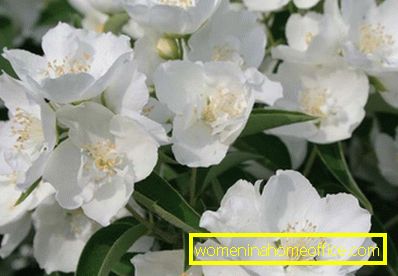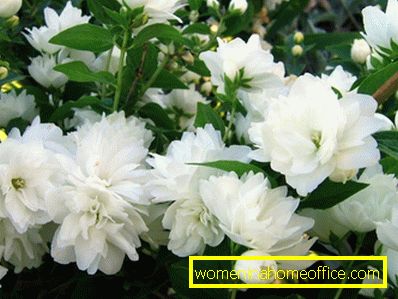Chubushnik
Chubushnik, better known by its different name - jasmine, is loved by many gardeners for their strong bright aroma and neat white flowers that can be a decoration for any site. Shrubs, often evergreen, in the middle lane are not very common. At the same time, in the matter of planting and care, the Chubushnik is not so complicated.
Chubushnik: varieties and main characteristics of the plant
This ornamental shrub belongs to the family of hydrangea, and it has a little more than 50 species. The height of their bushes is in the interval of 1-4 m. The crown of a bush is ovate, wide, the foliage is muted green, thick, has a short down from the bottom.

On the eve of autumn, most species of jasmine leaves get a golden hue, but there are evergreen bushes. Racemes inflorescences, tightly collected, final, white-flowered. The flower consists of 4-5 petals, is able to reach 5 cm in diameter, some varieties are devoid of the usual jasmine aroma.
Breeders most liked the chubushnik Lemoine, on the basis of which many hybrid varieties were bred. In particular, Avalansh grown from the end of the 19th century, is distinguished by an average bush height (up to 1.5 m) and aroma similar to that of strawberries. Therefore, domestic gardeners often call him "Strawberry". The shoots of the variety are thin, brown in color, actively leafy. Its flowering period is in July, the flowers are small, up to 3 cm in diameter, 2-3 pieces each. in the inflorescence on the falling branches. The disadvantage of this variety is its fragility in relation to frost: when the thermometer is lowered below -15 degrees, the bushes die.
Through breeding from the variety "Avalansh", the variety "Winter avalanche" was obtained, having several differences from its predecessor. In addition to the fact that it is more resistant to cold weather, this bush is covered with flowers so thickly that the branches cannot withstand their gravity, bending down. In addition, its leaves are larger - up to 4 cm in length against 2 cm in "Avalansh". Because of this, it is most often grown in the middle lane, in Siberia and in the Urals.

The next variety of jasmine, also well established in the middle lane, is “Mont Blanc”. The bushes are the same low - up to 2 m in height, but incredibly lush (2-2.5 m wide), studded with large (5 cm in diameter) soft white flowers that have almost no aroma. The main location of the inflorescences is the branches of last year's increments. Its flowering period is the end of the season, lasts 35-40 days.
Separately, it is worth noting a few varieties, focused on late flowering. "Flight of moths" in height reaches 4 m, rather compact, but with magnificent krone. It is covered with semi-double flowers, whose diameter is 3-4 cm, and the inflorescences form elegant openwork brushes, located on the branches of the 2nd order. They are somewhat raised above the foliage, which is why they resemble night butterflies.

A "Airborne" is easily distinguished from other varieties by the yellow centers in the white petals. Its flowers, similar to bells, have lowered perianths, and the spreading shrub itself is never below 3 meters. Flowering occurs in July.

Chubushnik: reproduction by cuttings and seeds
Jasmine grafting is the easiest way to reproduce it. If you want to take shoots from an existing bush, it is recommended to do it in the summer. Choose semi-woody cuttings, before or at the time of flowering. They should be placed for rooting in a cold greenhouse or a bed harvested the previous autumn.
It is desirable that the escape was already ready to bloom a flower and a small piece of wood, called the "heel". The easiest way to develop the root system of this cutting is to place it in a mixture of peat, drainage (rubble) and sand in its role, moistening all the components. Additionally, the fungicide solution is introduced into the substrate, and before the rooting process, the lower leaves of the cutting are removed. In the container it is placed at an angle (35-40 degrees) so that the leaves do not touch the ground, and the seedling is covered with a cap: for this, both a bank and a plastic bag will do. Mandatory procedure during the development of the root system of the cutting is his daily spraying.
Chubushnik breeding occurs not only by cutting, but also through sowing. However, this technology is allowed only for species specimens. Only it is rarely used, because the bush does not bloom earlier than on the 5th year after sowing. You can make it in spring and autumn, and even in winter in the snow. Moreover, the process of stratification is omitted: it is not necessary.
In winter, the seeds fall into the snow grooves, and in the fall - in the previously prepared ridges. They are submerged by 30 cm, after which they are covered with branches, spruce branches or dry grass. When the snow starts to fall, the organic shelter is removed. If the planting is carried out in the spring, then it is carried out in greenhouses or greenhouses, per 1 sq. M. takes 1 g of seeds. In order for their germination to speed up, experienced gardeners pour the seeds poured into a rag pouch with a solution of epin, and then lay them in the peat for 48 hours. Seeds mixed with river sand are placed in the grooves and overlapped with compost.

Chubushnik: planting and care in the open field
Although jasmine has long earned the title of an unpretentious plant, but it also requires some conditions. In particular, the place for planting the chubushnik should be flooded with light: the bush loves direct sunlight. In the penumbra, the flowering period may shift, and the inflorescence will begin to open reluctantly, will be frail and inconspicuous. In addition, in the shaded areas, thinning of jasmine leaves is observed, while under the sun, on the contrary, the density of the leaf plate increases, possibly increasing the brightness of its color.
With regard to the soil, everything is somewhat simpler: only its high moisture content is important. It will be good to plant a mite on the water, but not stagnant groundwater. Additional watering takes place in June and July, and 1 bush accounts for up to 20 liters of water. Chubushnik substrate may not be fertile, but it should not contain a lot of salt. However, it should be at least 2 times per season to feed the bush by introducing a mullein infusion into the soil. It is recommended to carry out this procedure until mid-August. In addition, annually a slurry is brought under the bush, as well as mineral fertilizers, which include urea, potassium sulphide and superphosphate. At the end of the flowering period, the soil is enriched with wood ash.
Planting period - autumn, in the period from September 10 to October 10. With an open root system, it is recommended to do this until the leaves open. If the chubushnik is planted in a group, the bushes maintain a free zone of 70-80 cm, sometimes the distance increases to 1.5 m. It is necessary to deepen the seedling by 50 cm so that the root neck is level with the ground, otherwise the process of its decay will begin. For the winter in the middle lane, the bushes are covered with snow, and if the winter is snowless, it is covered with fir branches and straw.
Chubushnik is an excellent choice for high hedges or compositions of low bushes. Due to the unpretentiousness and pomp of the crown, jasmine requires only a rare scrap, whose frequency can be reduced to 1 time in 4 years. And from the words of experienced gardeners, during the rest of the time you can forget about the need for any procedures.